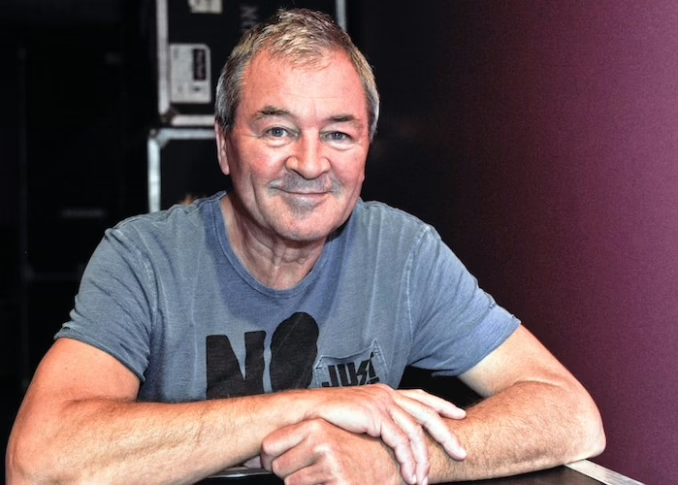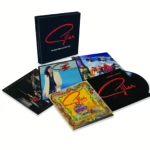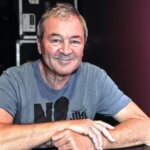
After leaving Deep Purple in 1973, Ian Gillan went on to form the Ian Gillan Band, an experimental jazz influenced band far removed from his Purple roots. By 1978 Gillan decided to form a new band and returning to a classic Hard Rock style. From 1979-1982 Gillan produced five albums over a particularly creative three year period. Mick Burgess called up Ian Gillan to chat about the Gillan years and the release of a new vinyl box set containing those classic albums.
In October you’ll be releasing Gillan: The Vinyl Collection 1979-1982. Are you looking forward to get this collection out and released?
I am very much looking forward to that. I haven’t seen the finished product yet but I’ve seen a photograph of the package and it looks great, it’s really good. I’m a big fan of the packaging of the vinyl records in particular. It’s a wonderful thing.
Why did you decide to release this collection at this point of your career?
Well if you think I had anything to do with it then you’re sorely mistaken!! I got a message a few weeks ago saying that the label was putting this boxed set out and asked if I’d do some interviews. They sent me a photograph and some details of what they were proposing and it looked good so I thought why not.
Does this mean that you might make a few quid out of this one?
Well I hope so. We’ll see about that.
This collection is purely a vinyl only release. Is it going to stay like that or is a CD collection in the works?
The CDs were comprehensively reissued with bonus tracks a few years ago so this will be just the vinyl. This will be special as it was the original format. It was a good time and just before CDs came in in 1982. This was the end of an era and the beginning of another. It was also the period of Post Punk and the middle of the New Wave of British Heavy Metal. That kicked off a whole new scene of things so it was an interesting time.
There’s something magical about vinyl from its feel, the look of it and the packaging. What is it that draws you to vinyl more than any other format?
Absolutely. The artwork was part and parcel of the whole thing. You got an insight into the artist whether it’s the sleeve notes, anecdotes or pictures on the cover. There’d be lots of intimate stuff that’d draw you in and of course the lyrics would be there and you’d find out all the people involved with the band from the engineers to the roadies. The whole packaging was fantastic. The transition to CD made it pointless putting lyrics in the CD artwork as nobody could read them and the covers were so small it just made the whole concept of artwork a waste of time. Now with mp3s not only is the artwork gone but the quality has gone too.
Is the artwork going to be as the original versions?
It’s going to be the whole thing so with Future Shock there’ll be the gatefold sleeve and the booklet and for Glory Road there will be the bonus album For Gillan Fans Only.
It’s quite a body of work considering you released five albums in four years. Were you very creative over that period of time or did your label pressurise you to make a record nearly every year?
It was all quite natural and it certainly helped that I had my own recording studios at Kingsway so we could go in as soon as anyone had an idea and record something and we’d eventually build up an album. It didn’t take very long. Nowadays, an album has to be an hour or so but back then you had 38 minutes as 19 minutes a side was the optimum time before you ran into technical problems. It was pretty easy to record enough material for an album but I do also remember the spontaneity. I remember once getting a call from Virgin saying they were putting a single out and the tapes were going to the factory that afternoon. They asked which song from the album I’d like as a B-side and I was appalled as the fans have already bought the album and shouldn’t have to pay twice for the same songs. I said to them I’d get them a B-side by 4:00 pm. I phoned the guys and said I’d meet them at midday. I said I was going to the pub to write some lyrics and told them to record something as quickly as they could at a fast tempo. I’d just read Edgar Alan Poe’s Descent Into The Maelstrom so I called the new song “The Maelstrom” and we put that onto the B-side of Mutually Assured Destruction. There was a lot of spontaneity and a lot of fun in the studio too. It was a very compact and prolific period for us as a band.
When you left Deep Purple, you formed The Ian Gillan Band, that had a much jazzier direction than Purple. Why did you change direction back to Hard Rock with Gillan?
That just ran its course like everything does. I knew I wanted to do something different but wasn’t sure what I was going to end up with but I knew I wanted something that was a little more direct and much less complicated. The problem with musicians is that when they get really good, they get a little less accessible and the music starts disappearing up their own backsides. They are more into self-gratification and they play music because they can. John Gustafson was my hero and he was an amazing character and an amazing musician and I was honoured and humbled ever to have been on the same stage as him but those guys were so good that they lost that directness with the public and I wanted to get back to something simple. “Fighting Man” was the catalyst as Colin Towns was playing that in the studio and the other guys were laughing at him, I guess because it was a simple ballad. I loved it and thought it was fantastic but I didn’t know how to handle it. I didn’t have the courage to fire the guys so I left my own band and started another one and we got Mick Underwood involved and John McCoy turned up at the studio one day and it went from there. I don’t really know how he ended up in the band but he looked great and played in exactly the style that I was after that was very direct, powerful and uncomplicated. Colin stayed with us and with Bernie there as our new banjo player who had such immense talent and personality and Bob’s your Uncle we had a new band. That’s how it went. We all just seemed to work so well together.
How did Bernie end up being part of Gillan?
I had seen him on the road in The Bernie Torme Band and they had opened for us a year or so earlier and as I was going out to get some fish and chips before the show and before I went I stood on the balcony at some university hall somewhere or other and he was doing a sound check and it was awesome. I made a note of him and knew he was one to call.
Your first release which is known as the Gillan album was only released in Japan. Why was that?
I didn’t decide anything, it was the record label. These things happen and if you sing it, record it then it’s out but the record label decided just to put it out in Japan but it did sell quite well on import elsewhere.
There’s a few songs that appear on both albums including “Secret of the Dance” and “Fighting Man”. Did you rerecord these for Mr Universe or did you use the original tracks?
We used a different lineup for Mr Universe so we rerecorded everything for that album.
How did you deal with the songwriting in Gillan?
I was the original guy that decided when I joined Deep Purple in ’69 that we’d share the writing credits, no matter who wrote what. If you’re in the room, you get a share. It was difficult in the old days for drummers and bassists to get a share in the writing because they were considered just to be part of the arrangement, not the songwriting itself. Traditionally the song was the melody, the tune and the words and that defined the song and probably still does. When you have songs built on riffs and chord sequences and the charisma and chemistry of the musicians then for me it’s a no brainer that everyone shares. That way everyone gets the credit and deservedly so. I brought that into my own band and it made things less complicated.
The For Gillan Fans free album only was always an interesting extra with the initial copies of Glory Road. Was this an odds and sods sort of release, a collection of songs left over from earlier sessions or did you record some specifically for the bonus release?
That gave the fans an insight into what was going on between takes in the studio and the banter that went on between the control room and the studio. It was very open and people could get an idea what the atmosphere was like in the studio. Most of it was just us mucking about in the studio. The idea was to share the intimacy of the studio and bring the fans in to show them how much fun we were having. There was stuff on there like “Egg Timer” and “Post Fade Brain Damage” and a version of an Elvis song, “Trying To Get To You” that we did for fun. We did that one live a couple of times and ran it through the studio but we couldn’t justify it a place on the album. There was also a drum thing called “Redwatch” that Mick did and a lot of outtakes and joking around that we thought would be interesting to the fans but you just can’t charge money for those things so we gave it away with the album.
Bernie Torme has spoken so positively of his time in Gillan and working with you and said he’d definitely like to work with you again. Is this something you’d like to do if you had the time?
I loved working with Bernie but I don’t think the band will play together again. It was literally of its era and I don’t think there’s any chance of going back to it. Quite apart from that, even if I did want to, in practical terms I can’t squeeze in anything for the next three years. My life is totally saturated with projects and the next Deep Purple tour is being planned already and there’s a new album due early next year and it’s immense the work ahead. I’m very happy to look back on this stuff and I think it’s fantastic but to revisit? I don’t think so. I don’t think there’s anything in my life that I want to revisit. I want to look forward and get as much done as I can before everything falls off.
The Vinyl Collection 1979-1982 by Gillan is out on Demon Records on 7th October and features five albums — seven LPs in total — including Mr. Universe (1979), Glory Road (1980; 2 LPs, with bonus disc For Gillan Fans Only), Future Shock (1981), Double Trouble (1981; 2 LPs) and Magic (1982).







Be the first to comment